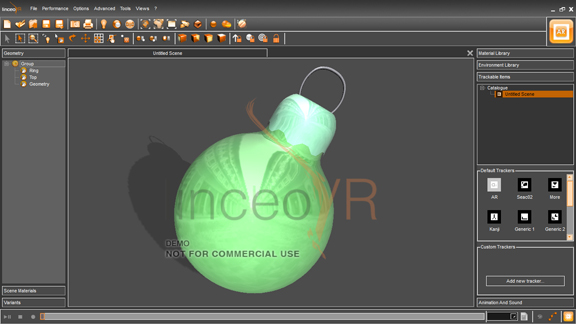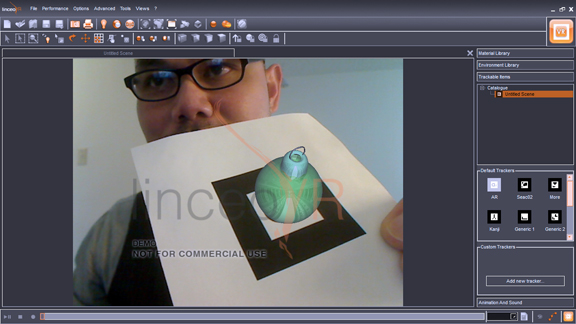September 15, 2011
Augmented reality—the use of sophisticated software to merge physical reality and digital objects—has been around for quite some time. Top-tier automakers like Ford employs it to test out the designs they’re developing in digital forms before they commit them to the production line. Because the practice usually involves high-end hardware and professional software (with heavy customization), the prohibitive cost has prevented it from going mainstream.
However, this may be changing. With a product like LinceoVR from SeacO2, you can get started with your very own augmented reality session for about $35 (€25)—less than the cost of a webcam. (OK, to make this work, you need to invest in a webcam too.) The simple, straightforward software is marketed as a real-time rendering, animation, and augmented reality package. The introductory version serves as a teaser to get you to purchase more options, like batch rendering, texture tracking, autostereoscope features, and so on. Still, at $35, I’d say it’s a steal just to get the augmented reality function alone.
First, go ahead and fire up your favorite CAD program, because you’ll need a 3D model to project into your reality (you need something to augment your reality with). LinceoVR cannot read CAD files in their native forms; but it can import neutral 3D formats, so you’ll need to save your CAD model as IGES, OBJ, VRML, or some other supported type. Once you’ve done that, you can import the object into a LinceoVR scene. If your model is strictly geometry, you can use LinceoVR’s preloaded textures and materials to add some realism to it. (The library is limited in the $35 version.)
In LinceoVR, you’ll find a Trackable Items tab. That’s the tab you use to associate the 3D model in the scene with a marker, or a symbol that’s easily recognizable to the computer’s eye (the webcam, in my case). The association is quite easy. You just drag a symbol from a collection that comes with the software, then drop it onto the model in the scene tree. (You may also create your own symbol, using a graphics or an image of your choice.)
Once that’s done, you print the marker onto a paper—no special paper needed, any regular printer paper will do. Then you can launch the AR, or augmented reality mode. LinceoVR prompts you to identify your VR source, or a camera attached to your PC. Once you select the appropriate equipment, you’ll see a preview. That’s just about all the setup you’ll need to do to get into augmented reality.
When the camera goes live, you can simply hold up the printed marker. You’ll see your digital model superimposed on your paper marker, as if it has been imported into your live video feed. As you move your marker, the 3D model will rotate and shift in response, always conforming to the orientation of the marker.
The software includes ray-tracing option, so you can work in a photorealistic view. If you want to take a snapshot or capture a movie clip of your interaction with the digital object, the software’s virtual camera will record it for you. (Your output is limited to low-res only in the introductory version.)
SeacO2 offers a free (downloadable) LinceoVR viewer, so, if you want to send more than a movie clip, you can send an augmented reality scene for offline viewing. And if you want to embed an AR scene into your PowerPoint presentation, you may download the PowerPoint plugin toolbar from SeacO2.
At a consumer-friendly price bordering on impulse buy, LinceoVR gives you an easy way to transport your digital models into live video feed. Beside fun, creative gimmicks you might try (for example, hold and rotate a 3D Mini Cooper in your palm), you may also use the method to compare real merchandize with digital models (a real iPod and a digital iPod, side by side).
As the use of digital prototypes overtakes processes once served by clay models and foam models, augmented reality may become the answer to test fitting, clashes, and aesthetic harmony between digital designs and physical components.
For a demonstration of LinceoVR, watch the video below:
Subscribe to our FREE magazine, FREE email newsletters or both!
About the Author
Kenneth Wong is Digital Engineering’s resident blogger and senior editor. Email him at [email protected] or share your thoughts on this article at digitaleng.news/facebook.
Follow DE







